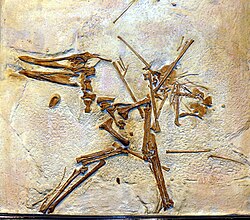Classification
In 2006, Lü Junchang and colleagues named the clade Boreopteridae for the clade containing the common ancestor of Boreopterus and Feilongus and all its descendants, which the authors reclassified as close relatives of the ornithocheirids, though Feilongus had originally been considered a gallodactylid. [5] [6] Originally considered close relatives of the ornithocheirids, many of these supposed boreopterids have since been considered members of other groups of the pterodactyloid lineage. Boreopterus and Feilongus were found by Andres and colleagues in 2013 to be closely related to Cycnorhamphus, making them members of the Gallodactylidae as had been originally thought when Feilongus was discovered. [7] However, a revised version of Andres' analysis, which was updated to include the other supposed boreopterids among other changes, found that Boreopterus itself, and therefore the name Boreopteridae, was indeed a member of the ornithocheiroid clade. This analysis confirmed that Feilongus was in fact a ctenochasmatoid, but one closely related to Gnathosaurus rather than Gallodactylus. This study effectively reduced the membership of Gallodactylidae back to just Gallodactylus and Cycnorhamphus. [7]
Cladogram following the latest version of Andres' data set, published by Longrich, Martill, and Andres in 2018, highlighting the positions of several possible gallodactylids: [8]
In a 2014 study, Steven Vidovic and David Martill concluded that Pterodactylus scolopaciceps , usually considered a synonym of Diopecephalus and/or Pterodactylus , was not closely related to other Pterodactylus specimens. They placed it in the new genus Aerodactylus , which they found to be most closely related to Cynorhamphus. They initially named this clade Aurorazhdarchidae, and defined it as the most recent common ancestor of Aerodactylus scolopaciceps and Aurorazhdarcho micronyx, and all its descendants. [9] In follow-up studies, they found that this group is actually nested within the traditional grouping of Gallodactylidae. They proposed new, more restrictive definitions for both Gallodactylidae and Aurorazhdarchidae, and created another new clade, Aurorazhdarchia, with a definition equivalent to the old Aurorazhdarchidae. [10]
Cladogram following Vidovic and Martill, 2017, highlighting the positions of several possible gallodactylids: [10]
This page is based on this
Wikipedia article Text is available under the
CC BY-SA 4.0 license; additional terms may apply.
Images, videos and audio are available under their respective licenses.













